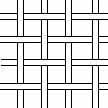
And not have it show?
As long as the areas along the edges have not been stitched and the two pieces of canvas are the same mesh, you can.
It’s easier than you think.
For about four threads along where you want the canvases to join, line up the two pieces so they align. You want it to look as if there is just one set of holes.
Hold the two pieces of canvas together and baste the pieces together using one strand of floss that matches the thread you will use to stitch the area. basting means you will not need to hold the canvas together while you stitch it all.
Stitch up to and through the double layer of canvas. Because the bulk is on the back and you have stitched over it, the join will not show.
Tips for Success
— This method only works for canvases of the same mesh and type. The hole size of different types of canvas are not the same, so this won’t work.
— You must be using a stitch that covers completely for this method. Open holes within your stitching will not look like a single layer of canvas.
— It’s better if only one side of the canvas is stitched with the area’s stitch. That way you have more flexibility in lining up the canvas. If both sides are stitched, even in Tent, you need to line up both the stitches and threads, which may be very difficult to do.
— While the basting keeps the layers together it will not hold them firmly in place. For your first few stitches at least you should hold the canvas to keep the holes lined up.
— You could use this method to add borders between the squares and on the edges of a rug. Just plan for the overlap and stitch the borders after the joins have been made.
About Janet M Perry
Janet Perry is the Internet's leading authority on needlepoint. She designs, teaches and writes, getting raves from her fans for her innovative techniques, extensive knowledge and generous teaching style. A leading writer of stitch guides, she blogs here and lives on an island in the northeast corner of the SF Bay with her family

Leave a Reply